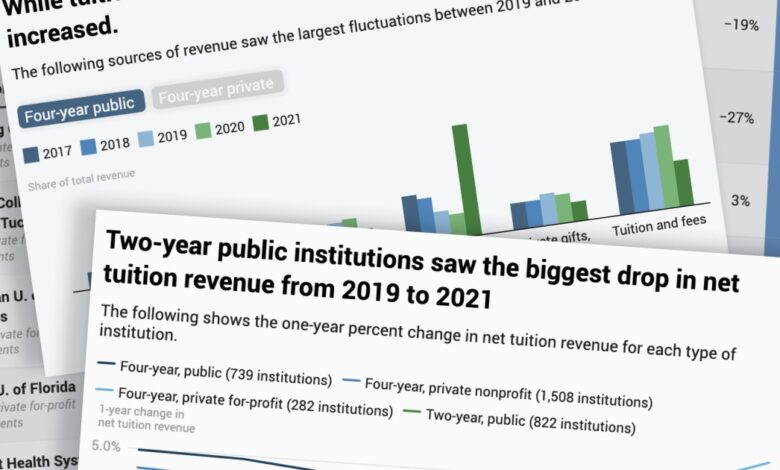Tuition Revenue Has Fallen at 61% of Colleges During the Pandemic

Net-tuition revenue — the money that institutions earn through enrollment minus any discounts and allowances provided to students — is the lifeblood of many universities.
It’s the largest source of revenue for private four-year colleges, and it accounts for just over $1 of every $5 of revenue for public four-year institutions, about the same, on average, as their combined earnings from state grants, contracts, and appropriations.
But over the first part of the Covid-19 pandemic, 61 percent of campuses saw that source of revenue fall. A likely factor in the dip was colleges’ struggle to bring back students two years into the pandemic, according to a Chronicle analysis of finance data from the Integrated Postsecondary Education Data System, which examined how net-tuition revenue fluctuated from 2019 to 2021.
While the majority of colleges did see a decline in their net-tuition revenue, some types of institutions fared worse than others. More than seven out of 10 community colleges saw that source of revenue drop from 2019 to 2021, while four-year institutions fared slightly better: 60 percent of public colleges and 58 percent of private colleges experienced drops in their net-tuition revenue.
A larger share of highly residential colleges saw a decline in their net-tuition revenue compared with nonresidential and primarily residential institutions; nearly two out of three highly residential campuses reported tuition-revenue drops, while 48 percent of nonresidential institutions and 62 percent of primarily residential campuses experienced declines.
Institutions that were more selective in their admissions weren’t spared. The majority — 55 percent — of institutions defined as more selective by the Carnegie classifications saw a negative change in revenue from tuition, which was not much better than the 59 percent of inclusive institutions reporting net-tuition revenue declines. Sixty-two percent of selective institutions experienced drops.
While net-tuition revenue typically accounts for a substantial share of a college’s income, investment returns became the leading source of revenue for private nonprofit institutions in 2021 (a trend that seems unlikely to repeat itself in 2022).
Notes:
The two charts in this story and the description of four-year colleges’ finances are based on an analysis of over 3,400 degree-granting institutions in the United States that are eligible to participate in Title IV financial-aid programs. The table and other information presented at the institution level are based on a smaller subset of 2,400 colleges with enrollments over 500 students and tuition revenue greater than $500,000. Enrollment and financial figures used throughout this analysis are from the falls of 2019 and 2021, and from the 2021 fiscal year.
Values are compared over time using a college’s Ipeds unit identification number. Institutions can merge, consolidate, or split using the same unit ID, which may account for some large variations from year to year.
Definitions of institutional selectivity and residential type follow the Carnegie classification’s Undergraduate Profile and Size and Setting listings.
Source link






